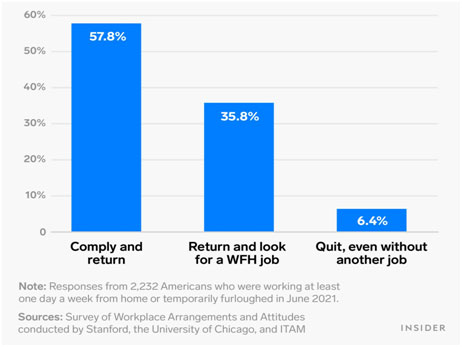As the horrific pandemic began to wane this year I’ve had the privilege of speaking with hundreds of enterprise executives and managers at many restarted, in-person events. Most of these individuals (approximately 90%) have explained to me that their organizations are fully supporting Hybrid Working. Interestingly, it was like the parable of the Blind Men and the Elephant (where each person touches a different part of the elephant and describes it differently.) Every organization embracing Hybrid Working seems to have a different definition of how to execute it, and most are simply not sure yet.
I should clarify that this model does not impact the outliers. Hybrid Working is not appropriate for people that physically interact with their environment –Security Guards, Jack-Hammer Operators, Baristas and the like will never be able to take advantage of remote working. Neither will organizations whose leaders see the old model as a facet of power and control – they will sadly not be coaxed into a more productive future.
For the rest of us, however, the frequently mentioned Future of Work does represent significant improvements, but it is definitely a work in progress. We may not know exactly how all aspects of it will look in the next few years, but we can definitely provide solid guidance about what we’ve learned so far about organizations and their knowledge workers.
-
- Formulas fail every time. As soon as organizations tell people how many days they must be in-office versus working remotely they’ve completely lost sight of the advantages of hybrid working. Organizations needs to hire smart people that can self-determine the best place to work from on any given day. If they don’t perform, then they weren’t right for the job. If they do then firms have no reason to remove their work location autonomy.
- Coercing “return to office” does not work. No matter how many free-donut days or spa-style massages are offered on site it will not draw significant numbers of employees back to an office that they no longer perceive they need to be in. In addition, if told they ‘must come back if they don’t want to lose their job’ approximately forty percent are just quitting – either immediately or making the decision to look for alternate work and leaving as soon as they can.
 Enterprises need to recognize that the old-style office – a place where knowledge workers do desk work and occasionally meet together – is as dead as the dinosaurs. Successful organizations will have to accept that changes are inevitable, and that they don’t want to be one of the last to change if they want to attract and retain the best employees.
Enterprises need to recognize that the old-style office – a place where knowledge workers do desk work and occasionally meet together – is as dead as the dinosaurs. Successful organizations will have to accept that changes are inevitable, and that they don’t want to be one of the last to change if they want to attract and retain the best employees.
- Toss-out old office designs. ‘Densified’ desks, open plan layouts, xx number of audio conference rooms and videoconference rooms per employee, etc. are all wrong now. We must create office spaces that are specifically intended to foster group collaboration. Set aside desks for the support people that need to be there every day, but make-sure the remaining desks are reservable as hoteling or touch-down spaces and focus rooms for people who are not there every day. Make the majority of rooms specifically for group collaboration, with lots of space to support brainstorming, whiteboarding and scrap-boarding on the walls, and videoconferencing. Understand that EVERY meeting going forward will likely have at least one remote participant, so the era of the audio conference only room is over. Every room needs to be equipped with modern, AI-driven videoconferencing that uses cameras without distracting in-room motors and without complicated, custom-programmed, in-room touch-panel controls. The in-room technology needs to be as simple as possible and must operate by itself wherever possible.
- Establish and standardize home office set-ups. The organizational “campus” is not just the on-site buildings anymore. It stretches to every knowledge worker’s home office. Your half-million dollar boardroom is only as good as the potentially cheap webcam your employee might be using to connect to it, and your support staff’s ability to troubleshoot said device. Remote employees need good quality systems for working with peers and clients, and those systems need to be supplied by the enterprise to ensure the consistency of quality and reliability that enterprises require. Also, beyond just the appropriate tools, remote workers need an established location in their home from where to work. “Going to work” is a state of consciousness that can only be established and maintained when there is a daily spot to go to. It can’t be a spare bedroom today and the kitchen table tomorrow if employees want to be effective at their job.
- Hire and train good people managers. It is completely wrong to believe that managers cannot effectively supervise a team when their employees are remote. Global teams and twenty four hour / seven day a week staff have been effectively managed remotely for years. Organizations need to avoid just promoting good performers into management roles. They must either hire managers with a track record of success managing remote teams or provide new managers with the training needed to effectively manage remote teams. The proverbial ‘mean / strict’ manager is no longer an organizational advantage. It is now in-fact a force to drive away your best employees.
- Remain open and flexible. Organizations and employees are still very much in the ‘figuring all of this out phase’ Be the person in your organization that asks both the ‘why’ and ‘why not’ questions. Try new things, fully assuming your employees and colleagues have the best possible intentions as everyone tries to create a new balance between health, safety, life and work.
When organizations come to the inevitable realization that ‘the home is the new office, and the office is the new offsite’ the future of work becomes easier to see. It is plainly ridiculous for employees to commute to an office to sit at a tiny, open-plan desk to do individual work and connect with global colleagues using technology that can be just as easily accessed from a remote office – there is zero advantage to operating that way, other than supporting a manager who may lack the skill to manage remote employees. Organizations must make their offices places that offer advantages which working from home cannot provide. They have to transform from locations where individual work is done to locations where group and collaborative work is done.
The new, modern, smaller footprint offices do need to install modern collaboration technology in their rooms. Many of the newer systems available today are now smart enough to perform the needed meeting tasks without user intervention. Starting a meeting, aiming cameras at who is speaking, showing everyone in person and remote equally, transcribing, and much more are all tasks done by today’s (far less expensive and available off-the-shelf) collaboration systems. The days of expensive custom programming and multiple component systems are over for all but the very largest specialty rooms.
So, when we look back at this period in a few years we’ll plainly see how office work changed, people’s choices about where and how to live changed, and cities and communities changed to adapt to the new model we’re all beginning to embrace. The future of work is here now, but fasten your seatbelts as ‘the ride ain’t over yet.’













